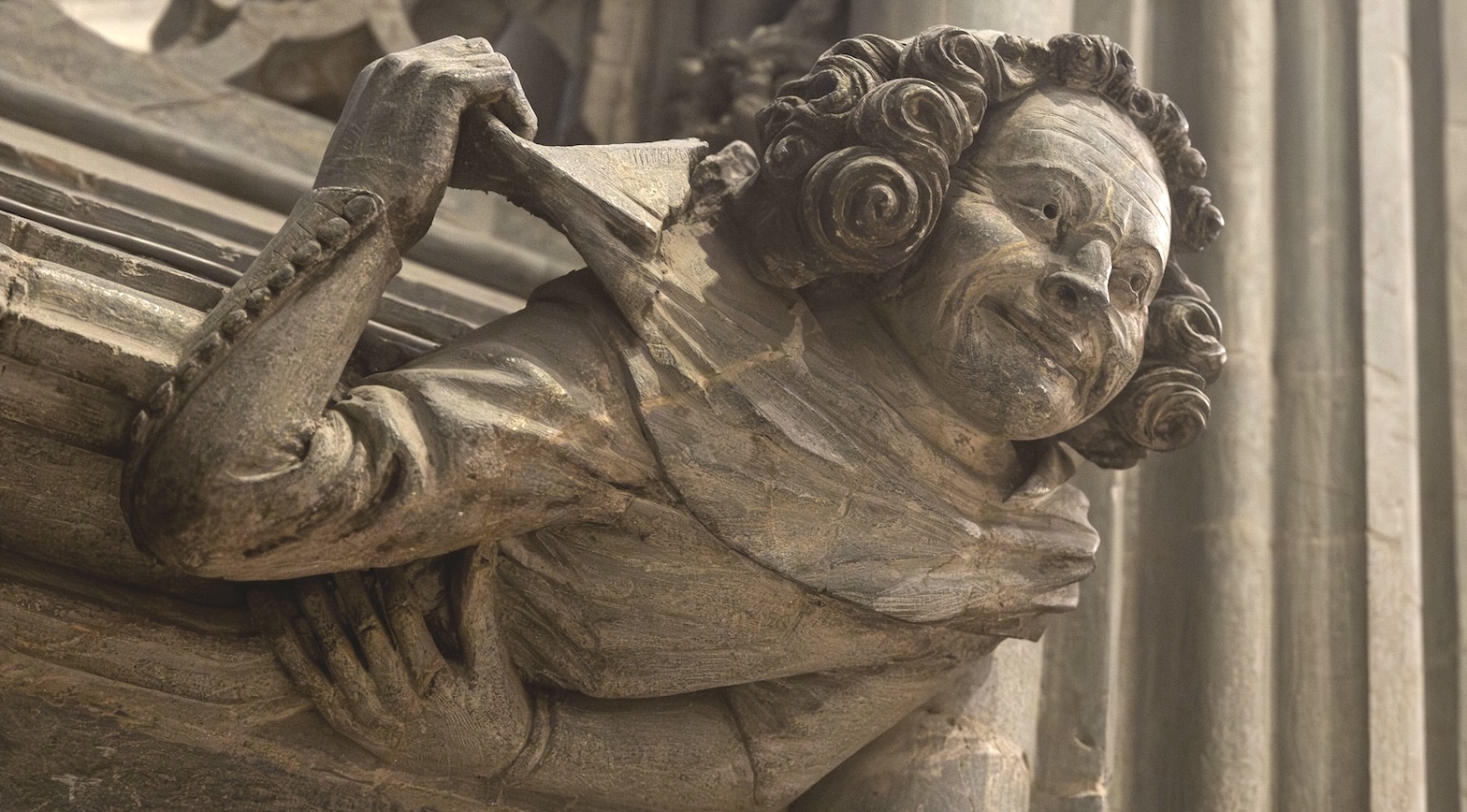The cathedral at the end of the world
Trondheim’s Nidaros Cathedral is full of secrets, messages from the past written in stone. One researcher is now decoding these missives, half hidden in a very special spot in and around the most sacred place in the church.
Nobelmen and women, in fancy clothing and pearls – but with dragon wings and tails. A laughing man with a full head of curly hair. Lions biting the ears off a man whose mouth is full of writhing serpents.
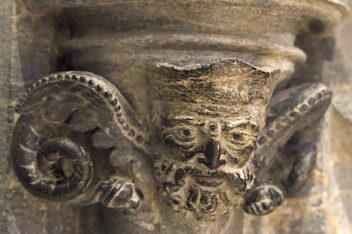
Clearly a member of the aristocracy. But what’s with the weird wings coming out of his neck? And that tail? Photo: Sondre Sivertsen, NTNU
These may sound like a weird combination of a gothic novel and a nightmare, but it’s something completely different – a description of some of the eerie and surprising sculptures in Nidaros Cathedral, the northernmost gothic cathedral in the world.
But what were the messages that stonemasons and religious leaders were trying to send visitors to the cathedral – and how do we interpret these messages hundreds of years later?
- You might also like: Thousand-year-old cathedral surrenders its secrets, stone by stone
The cult of St Olav
Nidaros Cathedral’s long history is part of the reason it has been an attraction for both pilgrims and now, researchers.
You can find parallels, especially in English cathedrals, and you can connect them, but the Octagon has no parallel. Not in Northern Europe, at least not north of the Alps. So there is something special about this.
The first stones for the cathedral were laid in the late 1100s, when a church was built over the shrine of St. Olav, the Norwegian Viking king who is generally credited with bringing Christianity to the country.
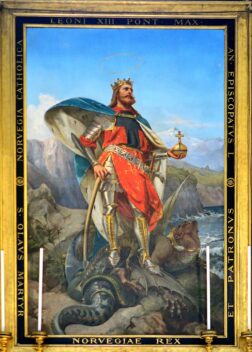
St Olav of Norway, also called the Eternal King of Norway. Painting by Pius Welonsky (1893) in Sant’Ambrogio e Carlo al Corso, Rome. Image: Rabax63, Wikimedia Commons CC BY-SA 4.0
Olav was killed in the Battle of Stiklestad in 1030 and canonized a year later, in 1031.
“The high altar still today stands on the place, pointed out as where St. Olav was buried after he was killed in the battle of Stiklestad on the 29th of July 1030,” said Øystein Ekroll, chief archaeologist and researcher at the Nidaros Cathedral Restoration Workshop, on the latest episode of 63 Degrees North, NTNU’s English-language podcast.
The high altar is surrounded by the Octagon, an eight-sided structure that is quite unusual as gothic cathedrals go, Ekroll said.
“You can find parallels, especially in English cathedrals, and you can connect them, but the Octagon has no parallel. Not in Northern Europe, at least not north of the Alps. So there is something special about this. Why build an octagon? Why not a square or a circle? We have round churches, we have square churches, we have cruciform churches and so on. Why an octagon?” he said.

These days, the Octagon contains the high altar of Nidaros Cathedral, but in the early days of the church in the 1300s, St Olav’s shrine was also displayed in the innermost part of this part of the cathedral. Photo: Sondre Sivertsen, NTNU
Ekroll thinks the Octagon was built – and subsequently re-constructed stone by numbered stone in the 1500s – as recognition that it was a martyrium, a place where St. Olav’s holy remains had been buried.
Pilgrims would come to the cathedral because of Olav, so the sculptures in and around the Octagon, where visitors would walk to be near the shrine, took on extra special significance. It was a place where the most important messages would reach the greatest number of people – in theory, at least.
- You might also like: What medieval skeletons tell us about modern-day pandemics
Dramatic events help date sculptures
But that’s not the only reason this special subset of sculptures is so interesting.
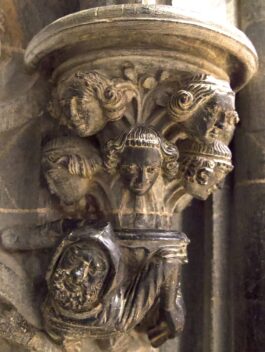
These are among the sculptures that were carved for Nidaros Cathedral in the aftermath of the great fire of 1328. Photo: Sondre Sivertsen, NTNU
Margrete Syrstad Andås is an art historian and associate professor at NTNU’s Department of Art and Media Studies who is at work on a book about cathedral’s sculptures. Unlike many other parts of the cathedral, she says, two dramatic events enable researchers to actually date the sculptures.
In the Catholic church, in the medieval times, Ultima Thule is this place. It’s the frontier against the north, against everything that is unknown and terrifying.
So what happened?
“In 1328 disaster strikes,” Andås said on the podcast. “It’s a huge fire and it takes everything of wood inside, probably the shrine is damaged, bells are damaged. Letters are preserved where the bishop writes to other bishops to encourage them to send money because they need to redo his cathedral. And that’s when the restoration of the Octagon takes place. So it is originally 12th century, but then they start restoring in 1328”
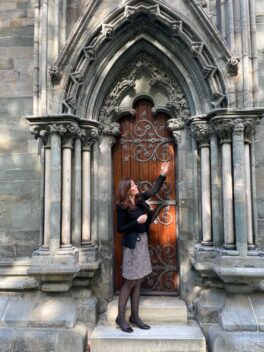
Margrete Syrstad Andås in the external doorway that leads to the Octagon. There are very odd sculptures here, too, including a man whose ears are being chewed by lions, and who has serpents writhing out of his mouth. Photo: Nancy Bazilchuk, NTNU
The importance of the cathedral, at the known limits of the Catholic world, was such that the Pope himself promised 100 days of indulgences to anyone who would contribute to the reconstruction. The stone masons must have begun almost immediately to carve the intricate and weird sculptures around the Octagon.
Because not long afterwards, in 1349 …
The Black Death
“Disaster really, really strikes because then the Black Death comes and 70% die in Trondheim. And we have a very defined period of time from 1328 when we know exactly when the sculptures here are done,” Andås said.
That makes the carvings a kind of snapshot in time, underscoring what religious leaders might think were the most important things people needed to know to save their souls, for example.

Theodor Kittelsen’s “Pesta i trappen” (The Black Death). The Black Death is estimated to have caused as much as a 60-65 per cent drop in population numbers in Norway after it arrived in the country in 1349. Norway’s population didn’t fully recover until the 17th century. Image: Norwegian National Museum
In this case, the person behind the messages was Archbishop Eiliv Korte. At the time, Andås said, Nidaros Cathedral was seen as a remote but important outpost of the Catholic Church – so remote they called it Ultima Thule, meaning the farthest known reaches of the modern world.
“In the Catholic church, in the medieval times, Ultima Thule is this place,” she said. “It’s the frontier against the north, against everything that is unknown and terrifying, and also not Christian. They talk about that themselves in Norse sermons, that’s where evil comes from, and it’s against the Samis, it’s against the unknown, those who are not Christianized. So they see themselves as a frontier as well, as part of the Catholic church.”
- You might also like: Icelandic drinking horn changes our understanding of St. Olav
The souls of the faithful
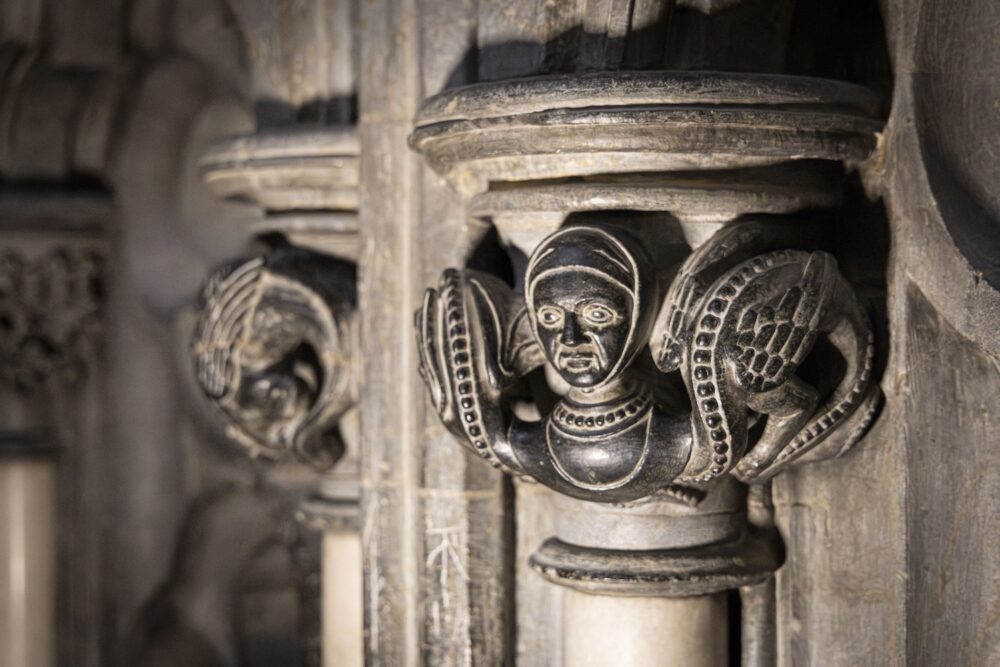
This nobel woman gazes down on pilgrims who would have walked around the Octagon in Nidaros Cathedral. But what is she telling them? Photo: Søndre Sivertsen, NTNU
It’s hard to overestimate the importance of religion in medieval Europe, Andås says.
“I don’t think we can quite imagine what that kind of a life was like, and how much more today, you don’t necessarily feel that you’re standing on the edge of death at all points in time. But I think within a society like that, you will be much more aware that you never know how much time you have,” Andås said. “And I think that’s sort of a backdrop, when you look at the sculptures, reminding you about all the sins that you need to keep in mind right now, you can’t wait until tomorrow.”
So one thing these strange half-human, half mythical creatures do is to warn pilgrims and the clergy how not to behave. To our 21st century eyes, these sculptures are puzzling – what message can they possibly send?
But Andås says the imagery, of a hybrid creature, was well known in medieval times. And part of the message they were sending was about sex.
“Archbishop Eiliv, the guy who started the restoration works, has regulations for the lay people on how to behave. And the sin of sexuality is of course, a recurring theme,” she said.
“Of course they’re humorous and they’re playful, so they’re funny in a sense. But they’re also a sense that we are in a decayed moral state. You’re not this and you’re not that, which it ain’t good. And having a tail can never be good in medieval Christianity. It refers to everything that is bad, essentially, the devil’s work,” Andås said.
To learn more about the sculptures and what they tell us about about life in the Middle Ages, listen to this episode of 63 Degrees North:
References:
Andås, Margrete Syrstad. “Art and Ritual in the Liminal Zone.” In The Medieval cathedral of Trondheim : architectural and ritual constructions in their European context. Eds. Margrete Syrstad Andås, Øystein Ekroll, Andreas Haug and Nils Holger Petersen. Brepols 2007: 47–126.
Andås, Margrete Syrstad. “The Octagon Doorway: A Question of Purity and Danger?” In Ornament and Order. Essays on Viking and Northern Medieval Art for Signe Horn Fuglesang. Edited by Margrethe C.Stang and Kristin B. Aavitsland, 97-134. Trondheim: Tapir, 2008.
Ekroll, Øystein. (2015).The Octagonal Shrine Chapel of St Olav at Nidaros Cathedral. An Investigation of its Fabric, Architecture and International Context [Doctoral dissertation, NTNU, Department of Historical Studies]. NTNU Open. http://hdl.handle.net/11250/2372702
